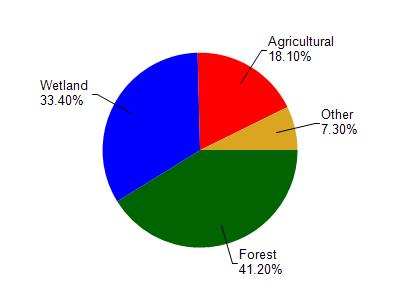Langlade
No
No
Yes
Fish and Aquatic Life
Overview
Greater Bass Lake is a very soft water drainage lake having acid, light brown water of moderate transparency. The inlet stream is drainage from Summit Lake and the outlet flows to Water Power Lake. The immediate shoreline is predominantly hardwood upland (95%) with the remainder being wetland of bog, shrub and conifer. Lake bottom materials are composed of sand (55%), muck (25%), gravel (15%), rubble (4%), and boulders (1%). Aquatic vegetation is sparse. Fish species known to inhabit this lake include muskellunge, northern pike, walleye, largemouth bass, perch, bluegill, black crappie, pumpkinseed, and white sucker. A public boat landing with limited parking is located on the west shore near the outlet. Navigable water access is possible with small craft via the outlet stream. Shoreline developments include 165 dwellings; one resort was formerly present, but has recently been subdivided. Of the 6.90 miles of shoreline 0.02 mile is public and controlled by the Town of Upham.
Source: 1977, Surface Water Resources of Langlade County Greater Bass Lake T-33-N, R-10-E, Sec. 12, Surface Acres = 246.3, Maximum Depth = 27 feet, Secchi Disk 7 feet.
Date 1977
Author Aquatic Biologist
Condition
Wisconsin has over 84,000 miles of streams, 15,000 lakes and milllions of acres of wetlands. Assessing the condition of this vast amount of water is challenging. The state's water monitoring program uses a media-based, cross-program approach to analyze water condition. An updated monitoring strategy (2015-2020) is now available. Compliance with Clean Water Act fishable, swimmable standards are located in the Executive Summary of Water Condition in 2018. See also the 'monitoring and projects' tab.
Reports
Recommendations
Wastewater Monitoring or Management
The Greater Bass Lake Protection and Rehabilitation District proposes to evaluate alternatives for wastewater disposal around Greater Bass Lake. Project activities include 1) cost effectiveness analysis of wastewater treatment alternatives (holding tanks/trucking, sanitary sewer, community on-site system, and replacement with similar systems) 2) recommendation and selection of alternative 3) meetings with district board and the public on alternatives, and 4) review comments from state and federal agencies.
Management Goals
Wisconsin's Water Quality Standards provide qualitative and quantitative goals for waters that are protective of Fishable, Swimmable conditions [Learn more]. Waters that do not meet water quality standards are considered impaired and restoration actions are planned and carried out until the water is once again fishable and swimmable
Management goals can include creation or implementation of a Total Maximum Daily Load analysis, a Nine Key Element Plan, or other restoration work, education and outreach and more. If specific recommendations exist for this water, they will be displayed below online.
Monitoring
Monitoring the condition of a river, stream, or lake includes gathering physical, chemical, biological, and habitat data. Comprehensive studies often gather all these parameters in great detail, while lighter assessment events will involve sampling physical, chemical and biological data such as macroinvertebrates. Aquatic macroinvertebrates and fish communities integrate watershed or catchment condition, providing great insight into overall ecosystem health. Chemical and habitat parameters tell researchers more about human induced problems including contaminated runoff, point source dischargers, or habitat issues that foster or limit the potential of aquatic communities to thrive in a given area. Wisconsin's Water Monitoring Strategy was recenty updated.
Grants and Management Projects
Monitoring Projects
| WBIC | Official Waterbody Name | Station ID | Station Name | Earliest Fieldwork Date | Latest Fieldwork Date | View Station | View Data |
|---|
| 1445500 | Greater Bass Lake | 10019011 | Greater Bass Lake -- Access | 6/5/2011 | 8/18/2012 | Map | Data |
| 1445500 | Greater Bass Lake | 10020018 | Greater Bass Lake -- Access | 8/18/2012 | 5/18/2021 | Map | Data |
| 1445500 | Greater Bass Lake | 10003148 | Greater Bass Lake | 5/19/1999 | 9/30/2017 | Map | Data |
| 1445500 | Greater Bass Lake | 343123 | Greater Bass Lake - Deep Hole | 6/20/1973 | 11/10/2025 | Map | Data |
| 1445500 | Greater Bass Lake | 344010 | Greater Bass Lake - Greater Bass Lake | 7/30/1979 | 7/30/1979 | Map | Data |
|

Watershed Characteristics
Greater Bass Lake is located in the Upper Eau Claire River watershed which is 221.36 mi². Land use in the watershed is primarily forest (41.20%), wetland (33.40%) and a mix of agricultural (18.10%) and other uses (7.30%). This watershed has stream miles, lake acres and 40,234.77 wetland acres.
Nonpoint Source Characteristics
This watershed is ranked High for runoff impacts on streams, Low for runoff impacts on lakes and High for runoff impacts on groundwater and therefore has an overall rank of High. This value can be used in ranking the watershed or individual waterbodies for grant funding under state and county programs.However, all waters are affected by diffuse pollutant sources regardless of initial water quality. Applications for specific runoff projects under state or county grant programs may be pursued. For more information, go to surface water program grants.